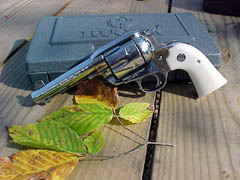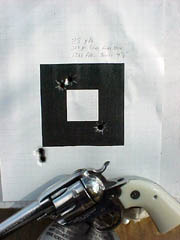|
Most everyone who is even slightly interested
in handguns, and particularly revolvers, knows of the surge in popularity of
Cowboy Action Shooting in recent years. As a result, we have seen a great proliferation of handguns, rifles,
and shotguns produced to meet the demands of competitors in the sport.
One such handgun is Ruger's Vaquero. The Spanish word
"Vaquero" translates to "Cowboy" in English. The marketing people at Ruger were doing
their job well when they named the gun.
In developing the Vaquero, Ruger used for the
basis their excellent Blackhawk design, with a couple of changes. The most
noticeable change was the front and rear sights. The Blackhawk has had, from
its inception, a set of good adjustable sights. For the Cowboy competitor, the sights were a serious
impediment to using the Ruger, as the spirit of the game calls for sights that were equal to the
ones in use in the 1800s. Ruger changed the sights on the gun to resemble in appearance
and function the ones on the Colt and Remington single actions of the period.
Shooters reaction to the Vaquero has been both positive
and overwhelming, as it seems as if the supply of the guns still cannot meet
the demand.
It wasn't too long after the introduction of the
Vaquero that Ruger mated its smooth-topped frame with the grip from their excellent Bisley
model. The resulting Bisley Vaquero model is the subject of this article. The regular centerfire
Bisley model proved to be a real good design from the viewpoint of the shooter. The
Blackhawk and later Vaquero models were always good shooters for their intended
purpose, but can be painful with the heaviest loads. Another limitation of the Ruger Bisley is
that you can buy it in any barrel length you want, as long as it is 7 1/2 inches, and
any finish you want, as long as it is blued. The Bisley grip frame, as made by Ruger, goes a
long way toward taming the recoil of heavy bullet loads in the .44 magnum and .45 Colt.
The 7 1/2 inch barrel, however, while fine for accurate shooting, is a little too
long for a good packin' pistol, in my opinion. The Vaquero can be had in 4
5/8", 5 1/2", or 7 1/2" inch barrel lengths. By combining the
Bisley grip frame with the Vaquero design, Ruger gave us a good-handling, easy packin' revolver that was
also comfortable with the heaviest loads.
The gun chosen for this test is a 4 5/8" stainless steel Bisley Vaquero
with Ruger's ivory-polymer grips. The finish is, unlike the brushed finish on the stainless Blackhawks,
highly polished to a mirror shine. This was done, I believe, to look much like the
nickel finish on the old Colts but with all the advantages of stainless. The
finish will not peel, chip, or wear off. The gun has a good balance and feel in my hand. I greatly prefer
the handle on the old Flat top Rugers, the XR-3, to any grip that they have ever made,
including the grip on this gun. The only problem with the old Blackhawk grip
is that with real heavy loads, it wears out the patience on my middle finger. The recoil with that grip
causes the trigger guard to whack the heck out of that finger with every shot,
when shooting the 300 grain .44 loads. The Bisley grip just doesn't deliver
the recoil to the old finger as does the plowhandle design of the other Ruger
single actions.
For this test, I fired the Bisquero with three
different loads. One was Remington's UMC 180 grain jacketed soft points. The other
two were handloads with 200 grain and 300 grain hard-cast flat point bullets.
All testing was done at 25 yards and fired over a Pact Precision chronograph. The Remingtons moved
out of the barrel at over 1500 feet per second and shot to point of aim at
25 yards, grouping into about 3 1/2 inches. The 200 grain loads, which I shoot mostly in my old Flat top, shot
very low in the test gun, but could be regulated by carefully filing down the front sight.
The reason, however for trying out this gun was to determine how it would shoot with the heavy
300 grain bullets loaded to about 1200 feet per second. The sights were dead on
with this load at 25 yards. They actually chronographed at 1255 fps. The problem which surfaced during
testing was related only to the finish on the sights. The front sight has the same high
polish as the rest of the gun, and depending on the light can glare like the Sun, making a
precise sight picture impossible. I realize that this gun isn't made for bull's-eye
target shooting, but would still be much better with a non-glare finish on the front sight. I believe
that if I decide to keep this gun, I will use a checkering file on the rear surface of the front
sight. This would cure the only flaw that I could find with the gun, as I prefer properly
regulated fixed sights to adjustable ones on a revolver of this type. Cutting
the glare off the sights should tighten the groups considerably.
I think that in creating the Bisley Vaquero,
Ruger has made a gun for much more than Cowboy action shooting. This gun seems
more like a great, everyday, working gun than anything else. Cowboy shooting
is moving more in the direction of light, soft-shooting loads for the most part. Where the Bisley
Vaquero excels is in handling the heaviest loads for hunting, or protection from man or
beast. For
complete specifications and list prices on Ruger products, click
here.
Jeff Quinn
  
Got something to say about this article? Want to agree (or
disagree) with it? Click the following link to go to the GUNBlast Feedback Page.
|

The Ruger Stainless Bisley Vaquero

The Ruger Vaquero brings Ruger's legendary
ruggedness, accuracy and quality to a gun any traditionalist will love

The Bisquero shows good off-hand accuracy at 25
yards - dulling the front sight should render off-hand accuracy even
better
|
![]()